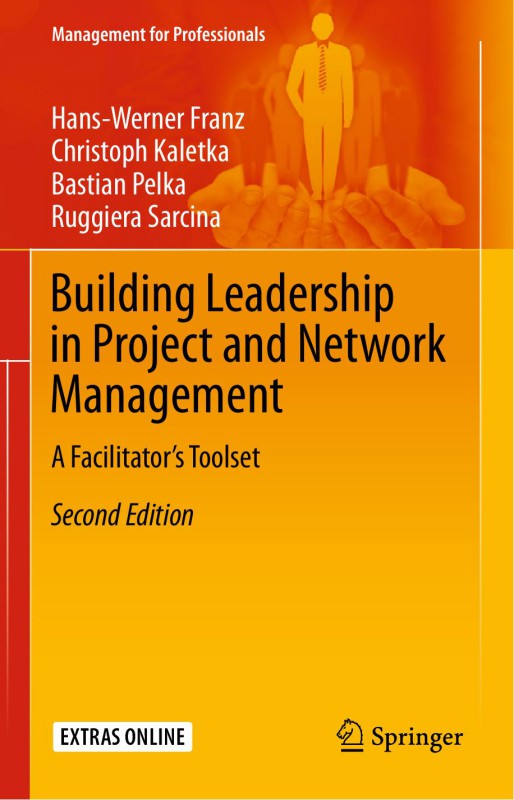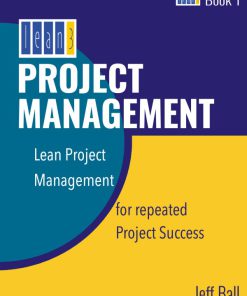(Ebook PDF) Building Leadership in Project and Network Management A Facilitator’s Toolset 1st edition by Hans Werner Franz, Christoph Kaletka, Bastian Pelka, Ruggiera Sarcina 3319782681 9783319782683 full chapters
$50.00 Original price was: $50.00.$25.00Current price is: $25.00.
Authors:Hans-Werner Franz , Series:Management [918] , Author sort:Franz, Hans-Werner , Languages:Languages:eng , Published:Published:Sep 2018 , Publisher:Springer
Building Leadership in Project and Network Management A Facilitator’s Toolset 1st edition by Hans-Werner Franz, Christoph Kaletka, Bastian Pelka, Ruggiera Sarcina – Ebook PDF Instant Download/DeliveryISBN: 3319782681, 9783319782683
Full download Building Leadership in Project and Network Management A Facilitator’s Toolset 1st edition after payment.

Product details:
ISBN-10 : 3319782681
ISBN-13 : 9783319782683
Author : Hans-Werner Franz, Christoph Kaletka, Bastian Pelka, Ruggiera Sarcina
This book introduces readers to essential facilitation techniques for leadership in the contexts of project and network management. It provides method-based messages, a facilitator curriculum, and a veritable arsenal of 50 carefully selected and ‘reality-tested’ tools for facilitation in non-hierarchical contexts. As such, readers will benefit just as much from learning by doing as from doing by learning. This book is also intended for all managers who are responsible for successful communication and co-operation in projects in and across organisations or networks of organisations, and who want to know how to share their plans effectively and improve collaboration. Though the book employs scientific principles, it is chiefly a practical guide, and draws on the authors’ extensive experience in consultancy and management.
Building Leadership in Project and Network Management A Facilitator’s Toolset 1st Table of contents:
1: Introduction to the Second Edition
The Book
The Projects
2: Messages for Facilitators and Lateral Leaders
2M1 The Functions and Roles of Network Facilitators
2M1.1 Network Facilitator
2M2 Moderation as a Role
2M2.1 The Goal of Moderation
2M2.2 The Tasks of Moderation
2M2.3 Host
2M2.4 Co-ordinator
2M2.5 Animator
2M2.6 Referee
2M3 Visualisation: Why and How it Helps You to Understand and Remember
2M3.1 Why Visualisation Helps
2M3.2 How Visualisation Helps
2M4 Basic Concepts of Perception and Communication
2M4.1 Sharpening Perception
2M4.2 Four Dimensions of Personal Communication
2M5 Basic Concepts of Learning and Competence
2M5.1 Learning
2M5.2 Competence
2M5.3 Learning Loops
2M6 The Concept of Responsibility
2M7 Basic Concepts of Organisation and Co-operation
2M7.1 Organisation
2M7.2 Co-operation
2M8 Basic Concepts of Management and Leadership
2M8.1 Managers
2M8.2 Leaders
2M8.2.1 Task
2M8.2.2 Group
2M8.2.3 Individual
2M9 Communities of Practice and Self-organisation
2M9.1 Communities of Practice
2M9.2 Self-organisation
2M9.3 Communities of Practice
2M9.4 and Communities of Performance
2M10 Basic Concepts of Knowledge and Knowledge Management
2M10.1 Knowledge
2M10.2 Competence Development
2M11 Project Work as a Work Style
2M12 The Nature of Quality: Continuous Improvement, Continuous Learning
2M12.1 Quality Definition of ISO 8402 (Used for ISO 9001 and 9004)
2M12.2 Total Quality
2M12.3 Elements of Management Quality
2M12.4 A Basic Theory of Quality
2M13 Basic Concepts of Small and Medium Sized Enterprises (SMEs)
2M14 Basic Concepts of Networks and Clusters
2M14.1 Networks
2M14.2 Clusters
2M14.3 Co-operative Agreements
2M14.4 Networking in Clusters
2M15 Learning Networks: Constructing Social Capital
2.M15.1 Networks and Social Capital
2M15.1.1 Learning Networks?
2M15.1.2 Can Organisations Learn?
2M15.1.3 Networks of Organisations
2M15.1.4 Learning in Networks: Constructing Social Capital
2M15.2 Levels of Functioning
2M15.3 Mechanisms of Functioning-and Learning
2M15.4 Mechanisms of Actualisation and Learning
2M15.5 Co-opetition Networks
2M15.6 Network Management as Facilitation
2M15.6.1 Learning in Networks
2M15.7 Six Dimensions and Action Principles of Network Management
2M15.8 Conclusions
2M16 Reminder-Konrad Lorenz Dixit
3: Didactics and Curriculum
3.1 Making Learning Easy: Facilitation and the Didactics of Action Learning
3.1.1 Introduction
3.1.2 What Do We Mean by Learning?
3.1.3 What Is Teaching?
3.1.4 What Is Good Teaching?
3.1.5 Eight Characteristics of Facilitative Didactics
3.1.6 More on Action Learning Didactics in this Book
3.2 A Curriculum of Action Learning: The Modules
4: Tools
Introduction
4A Improving Communication
4A.1 To-do Form
4A.1.1 To-do Minutes
4A.1.2 Other Uses
4A.2 Contract with Myself
4A.3 Chairing Vs. Moderating
4A.4 The Setting of Workshops
4A.4.1 Location and Space
4A.4.2 Equipment
4A.4.3 Food and Beverages
4A.5 The Planning of Workshops and Learnshops
4A.6 Learnshops or Learning Laboratories
4A.7 The Start-up Tool
4A.8 Warming Up or Ice-Breaking Methods
4A.8.1 Workshop (5-12 People)
4A.8.2 Kick-off Workshops (5-12 People)
4A.8.3 Larger Groups Meeting for the First Time
4A.9 Angles and Corners
4A.10 Brainstorming
4A.11 Brainwriting
4A.12 World Café
4A.13 Open Space
4A.14 Learner Satisfaction Analysis
4A.14.1 Smileys
4A.15 Learnshop Evaluation Annex: Learnshop Reporting Scheme
4A.16 Preparing a Meeting as a Chairperson
4A.17 Preparing an Online Meeting as a Chairperson
4B Collecting Information
4B.2 Semi-standardised In-depth Interviews
4B.3 Case Studies: Methodological Guidelines of Context Analysis
4B.4 Focus Groups
4B.5 Yellow Pages
4C Planning and Managing Projects
4C.1 SMART Five Basic Rules for Planning a Feasible Project
4C.2 Countdown Planning
4C.3 STEPP: Specific Tool for Excel-based Project Planning
4C.4 GOPP: Goal-oriented Project Planning
4C.5 Flow Chart
4C.6 Gantt Diagram
4C.7 Starting Projects
4D Analysing Problems and Preparing Decision Making
4D.1 Mind Mapping
4D.2 The Five Satisfactions (Stakeholder Analysis)
4D.3 Customer and Supplier Needs Analysis and Planning
4D.4 Flow Analysis and Planning
4D.5 Skill Needs Analysis and Planning
4D.6 SWOT Analysis Strengths, Weaknesses, Opportunities, Threats
4D.7 PEST Analysis: Picturing The Political, Economic, Socio-cultural and Technical Environment
4D.8 Cause and Effect Diagrams
4D.9 Force Field Analysis
4D.10 The Five Whys
4D.11 3C: Case Consultation with Colleagues
4D.12 Six Thinking Hats
4D.13 Pen Portrait
4D.14 Prioritisation: First Things First
4D.14.1 List of Options or Decisions
4D14.2 Decision Cross Importance Vs. Urgency
4D14.3 Diamond Ranking
4D14.4 Criteria-Based Decision Matrix
4D14.5 Plus-Minus-Implications
5: Growing Experience: From Unconscious Incompetence to Unconscious Competence
5.1 The SME ACTor Project Experience
5.1.1 Becoming a Facilitator: An Empowerment Process
5.1.2 Starting a Networking Project: The Context Analysis
5.1.3 Planning a Learnshop
5.1.4 Moderating a Learnshop
6: E-facilitating: How to Make Digital Learning Possible for Every Learner
6.1 ICT Based Co-operation and Learning
6.1.1 Social Media and Learning
6.1.2 Learning Theories-and How They Connect to Social Media
6.1.3 Practice: ICT Based Co-operation and Learning
6.2 Methodological Approaches Towards Community Based Learning
6.2.1 Spaces: Where to Acquire Digital Competences
6.2.2 People: The E-facilitator Profile
6.2.3 The E-facilitator Curriculum
6.2.4 Three Examples of Social Innovation Based Resources for Vocational Training
6.3 Final Remark
7: SME Internationalisation and the Role of Facilitators
7.1 About Internationalisation as a Decisive Competitive Factor for SMEs
7.1.1 Internationalisation
7.1.2 Internationalisation for SMEs
7.1.3 Obstacles SMEs Have to Face
7.2 Facilitating the Internationalisation Process
7.2.1 Selling Abroad or How to Become an Exporting Company
7.2.2 Facilitating at Two Levels
7.2.3 Facilitating the Decision-making Process at the Macro Level
7.2.3.1 Selecting the Target Market
7.2.3.2 Assessing the Degree of Export Readiness
7.2.3.3 Dashboard: A Specific Tool for Preparing, Monitoring and Improving the Company Performance
7.2.3.4 Lowering the Barriers
7.2.3.5 The Macro Level Facilitation Process: Recommendations and Final Remarks
7.2.4 Facilitating the Decision-making Process at a Micro Level
7.2.4.1 Assessing the Company Readiness on the Target Market
7.2.4.2 From the Fieldwork: The Self-assessment Check List
7.2.4.3 Preparing to Enter a Foreign Market
7.2.4.4 Entering a Foreign Market
7.2.4.5 Rooting in a Foreign Market
People also search for Building Leadership in Project and Network Management A Facilitator’s Toolset 1st
network leadership examples
project leadership roles and responsibilities
project management leadership examples
importance of networking in leadership pdf
project management leadership book












